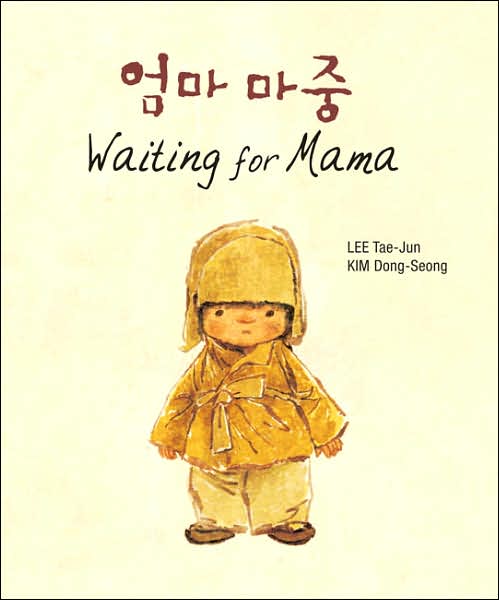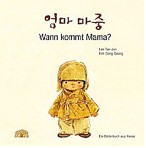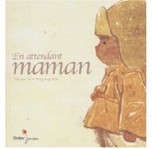Waiting for Mama
Written by Tae-Joon Lee
Illustrated by Dong-Sung Kim
North-South; bilingual edition, 2007
ISBN: 978-0735821439
This story takes place in the early 1900’s in Korea when the country was under Japanese occupation. The focus on a young child waiting for his mother at a public transportation stop may not be familiar to children who come from cultures in which parents or babysitters always accompany them in public. The story does not have a complex plot. The simplified text and repeated images of a boy waiting at the station create the sense of a young protagonist being watched through a hidden camera. The young boy goes to the platform of a streetcar station and waits for his mother to arrive. Every time a streetcar arrives, the boy asks the driver if his mother has come until one of the drivers tells him to remain in the safe area of the station. The boy stands still and waits, no longer asking the next drivers if his mother has come. Time passes and it gets darker and colder. The boy’s nose grows redder. Suddenly, snow comes down and the story ends with the scene of a town in which the roofs of the houses are covered with snow. The ending does not seem to have the closure typically expected in picture books. It is not a happy or sad ending, but rather an ambiguous one. A book ending with a young child waiting for his parent in the evening without the promise of the parent’s appearance seems unacceptable for an audience of young children. If you look closely the last page, however, things are not as they first appear. The small figures of the mother and child can be seen walking through the snow-covered scene.
Originally written in Korea, Waiting for Mama, 엄마 마중 [Umma Mah Joong], was published as a short story without illustrations in 1938. The illustrator of this picture book, Dong-Sung Kim, added his interpretation and details from his imagination. For instance, the young protagonist’s gender was not clear in the original text (Kwon, 2003), nor was the illustrator’s subtle interpretation that the mother arrives and walks home with the boy. Kwon (2003) says, “Readers don’t know anything about the young boy, but make the presupposition that this is the boy’s first experience waiting for his mom at the station based on his naïve question to the driver. The story can be hopeful or desperate depending on the reader’s interpretation of the boy’s situation” (p.189).
The story may be more powerful because the author does not describe what the boy is thinking or feeling when he keeps repeating the question, “Is my mom coming?” (Kwon, 2003). The author of the original short story, Tae-Joon Lee, wrote many orphan stories. Kwon (2003) says that the not-yet-arrived mom is a metaphor of the sovereignty of Korea and the waiting child is a metaphorical expression of Korea longing for independence from Japan. The illustrator, Dong-Sung Kim, is a well known artist who pursues the uniqueness of Korean illustration style in his works. Because of the simplicity of the story, Dong-Sung Kim’s imagination plays significant roles for readers.
Despite the ending which causes concern in some cultures outside of Korea, this classic Korean story has been translated and published in other languages including German, French, and English. In Germany, a Korean/German bilingual book has been published, Wann Kommt Mama? [When will mom come?]. A French edition, En Attendant Mamman, was published in 2007. In 2006, an edition was published in Australia as Waiting for Mummy, and in the United States as a Korean/English bilingual book called Waiting for Mama in 2007. This U.S. edition places Hanguel (the written Korean language) on the top line above the English translation, showing the American publisher’s effort to highlight the origin of story.
The English translations of Waiting for Mama and Waiting for Mummy find ways to highlight that the mother does come in the ending in order to make the translation more culturally acceptable to readers in Australia and the United States. The Australian version pulls out the image of the mother and child walking down the path to put on the final copyright page and the U.S. version clearly states on the book jacket that the mother arrives and walks home with the boy. The Australian and American versions have distinctively different narratives of translation, yet similar considerations for an audience who is not familiar with this type of ambiguous story ending. The idea of leaving a young child alone without a guardian creates a tension for readers from these cultures. The two English translations reflect the strategies of publishers who negotiate between an audience’s cultural resistance and the pleasure of reading an international children’s book. Each finds a way to provide a textual indication to point readers to the internally embedded visual image of the young boy walking home with his mom.
This book can be read alongside other books originally published in South Korea and translated into English, particularly picture books that support deeper global connections through providing images of contemporary Korea. The universal theme of a child’s relationship with a pet can be found in My Cat Copies Me (Yoon Kwon, 2007). The issues of self-esteem and gender can be found in Something for School (Hyun Young Lee, 2008). The themes of imagination and family are highlighted in Minji’s Salon (Eun-hee Choung, 2008) and The Zoo (Suzy Lee, 2007). Children’s curiosity about what pets do when the family is away is found in While We Were Out (Ho Baek Lee, 2003). All of these books were originally published in South Korea and have been translated into English and published by Kane/Miller (www.kanemiller.com) in the United States.
Kwon, H. S. (2003). The relationship of mother and child in Tae-Jun Lee’s children’s books. Changbi Review of Children’s Literature, 21.175-192.
Yoo Kyung Sung, University of Arizona, Tucson, AZ
WOW Review, Volume I, Issue 2 by Worlds of Words is licensed under a Creative Commons Attribution-NonCommercial-ShareAlike 4.0 International License. Based on work at https://wowlit.org/on-line-publications/review/i-2/




2 thoughts on “WOW Review Volume I Issue 2”
Comments are closed.